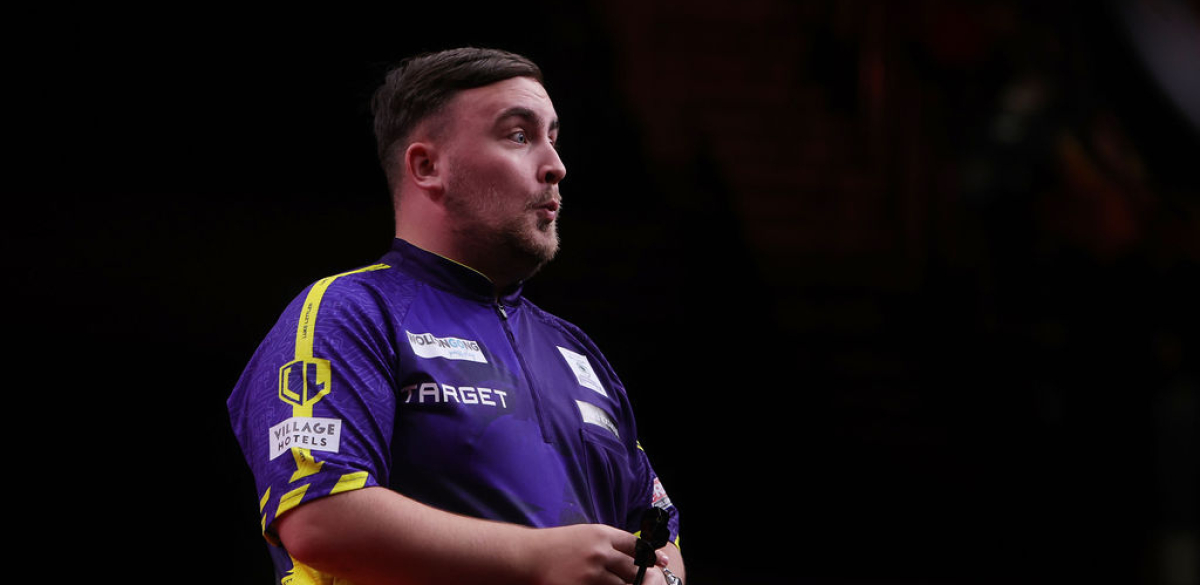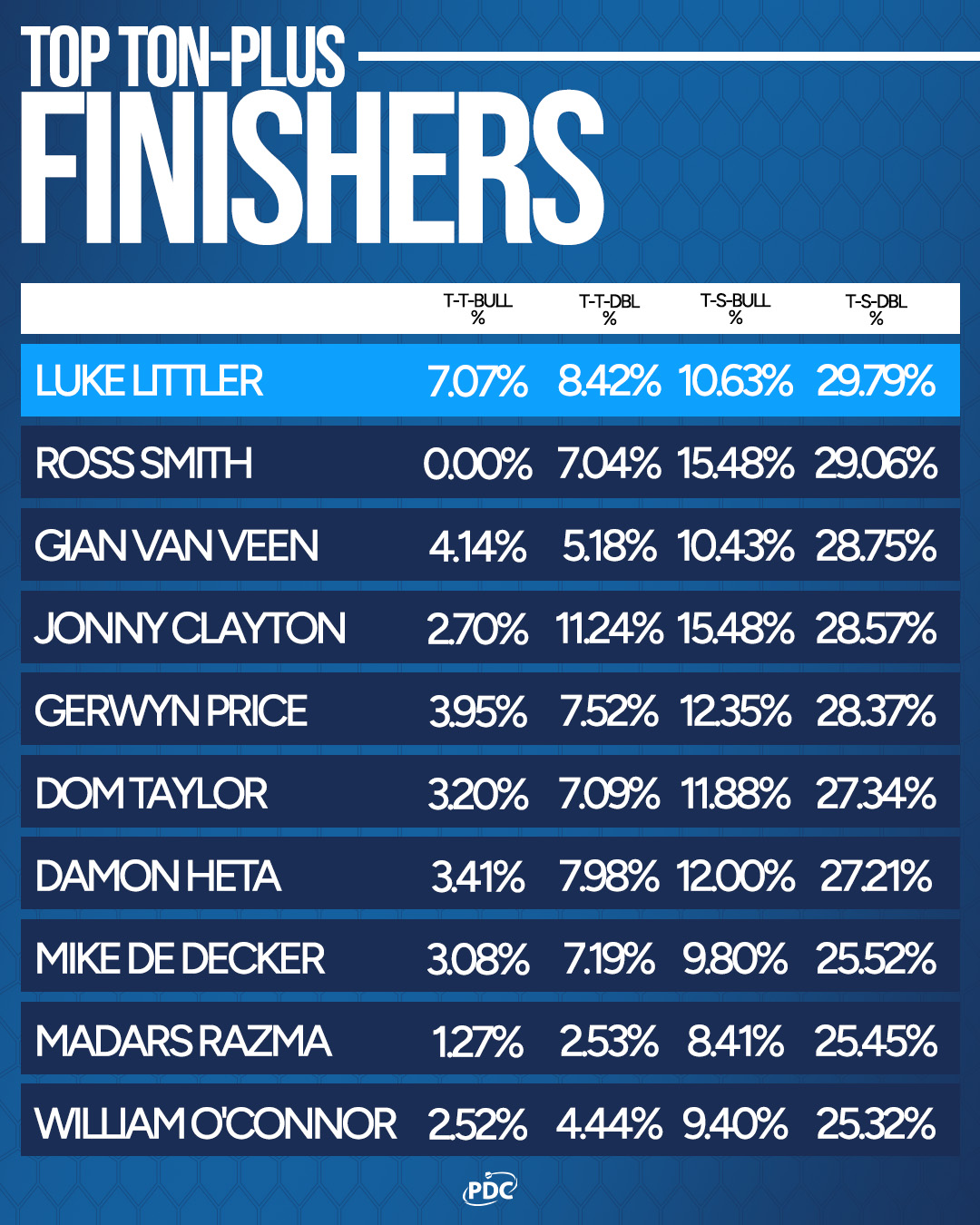
In his latest column, PDC Stats Analyst Christopher Kempf analyses the most prolific ton-plus finishers on the PDC circuit in 2025.

When statistics for 'ton-plus checkouts' are calculated, there is often only cursory recognition that not all of these finishes are equal.
This convention for tallying high finishes gives undue weight to the 100 checkout, which elite players often complete in only two darts and can expect to clean up within 3 darts nearly 50% of the time.
This marginalises the most difficult finishes, which require three accurate darts with no room for error.
Only with some additional research, moreover, can the interested fan discover how many attempts at those checkouts a player actually needed to arrive at his total of ton-plus finishes; this is the most relevant statistic to a player's skill in checking out from long distance.
The difficulty in arriving at an accurate picture of a player's ability to complete high finishes is twofold. Each checkout involves a different combination of trebles, and a large sample of attempts is needed to properly evaluate how proficient they are on each one.
Conversely, the long period of time needed to gather that large sample can encompass many months, during which a player's form may have radically improved or declined.
We can say, for instance, that from 2017 to the present Simon Whitlock has led the PDC in completing 14% of his 132 checkouts, but now that the Australian legend no longer holds a Tour Card, it's impossible to say whether Whitlock continues to maintain that standard in 2025 without comparing a trivial number of attempts between players.
What we can do, however, and what is attempted in this edition of Stat of the Week, is group together finishes of similar difficulty.
For instance, the finishes 161, 164, 167 and 170 all require two trebles and bullseye, which sets them apart from the finishes 131, 133, 134, 136-158 and 160, which are almost always accomplished by two trebles and a non-bullseye double.
Setting aside the different combinations of trebles and doubles used to complete each one, we can thus arrive at different 'tiers' of checkout difficulty in which most PDC players will have several hundred attempts per year.
Thanks to his penchant for completing 170 finishes in particular (he already has eight in 2025), Luke Littler leads the way with a 7.1% completion percentage on the treble-treble-bull finishes.
With the PDC average sitting at around 2.6% for these finishes, Littler is nearly three times better than the competition.
This figure may actually underestimate his true accuracy: as a prodigious scorer, Littler often finds himself in a position in which he can set up the double for his next visit without any concern that his opponent might check out in the intervening visit.
Five other players manage better than 5%, or one checkout in 20, but Ross Smith, with 150 attempts, has yet to complete one in 2025.
Yet Littler does not have the same advantage when it comes to the treble-treble-double finishes: he ranks only sixth among players with at least 100 attempts of these checkouts in 2025.
The top three places go to Josh Rock, Jonny Clayton and Cameron Menzies, the only three who complete 10% or more of their attempts.
In this category in particular, a higher number does not mean a higher difficulty; indeed, one of the easiest and most readily completed of these checkouts is 160, due to the use of treble and double 20, while checkouts like 131 and 133 are among the most infrequently attempted and completed of all three-figure finishes.
With the checkouts in the 120s we arrive at finishes in which a player can miss a target and still complete the checkout, with recourse to the bull.
On average these are easier for players to complete, but Littler unexpectedly struggles with these: with only 10.6% completion, he is in the bottom third of the PDC.
Rob Cross, on the other hand, has done nearly twice as well, breaking 20% accuracy (the only player to do so) and showing consistent performance across all finishes in this range.
Compare this to Jonny Clayton (#3 on the list), who has proven to be a 121-checkout specialist (better than 30% accuracy), but below average on the other treble-single-bull finishes.
Finally, we come to the lowest three figure finishes, in which a player has some choice in his checkout route - for instance, a 116 finish can be accomplished by throwing for treble 19 first, or for treble 20.
Note that this category includes 99, which cannot be completed in two darts, and excludes 100, which can.
Littler returns to form here, leading the way with 29.8% accuracy, but he is joined on top by Ross Smith, who makes up for failing to complete 161-170 checkouts by hitting 29.1% of his treble-single-double checkouts.
It becomes even more clear that accuracy in one tier of checkouts does not correlate with accuracy in another when we consider that Cameron Menzies, one of the best on TTD finishes, ranks near the bottom on TSD finishes, with only 16% accuracy.
To get a full, accurate picture of the state of competition in the PDC when it comes to high finishes, it isn't enough to compare the number of the highest finishes completed by two players in a match, or even to compare the number of finishes they manage to complete.
In so doing, we miss insights related to how different players perform when confronted with different types of checkouts.
We wouldn't know, for instance, that Scott Williams is actually more likely to complete a 121-130 checkout than a 101-120 finish, or that Jelle Klaasen has two checkouts greater than 160 on 70 attempts, but none between 136 and 160 on twice as many attempts.
Such information is important to recognising where players might succeed or fail relative to their opponents, or to the PDC as a whole.
Follow Christopher on Twitter @ochepedia